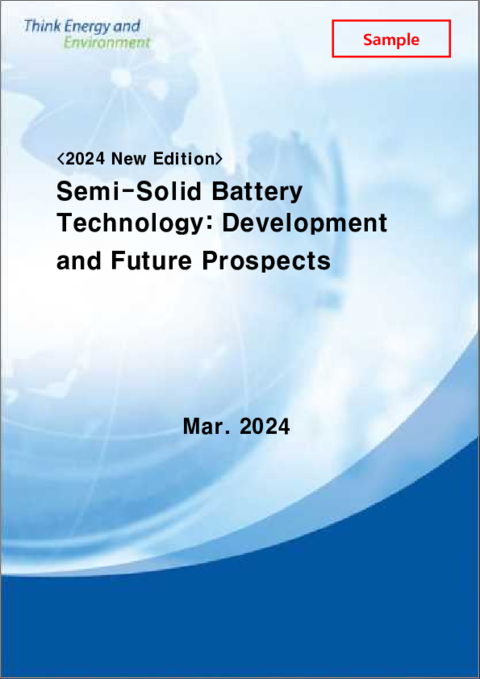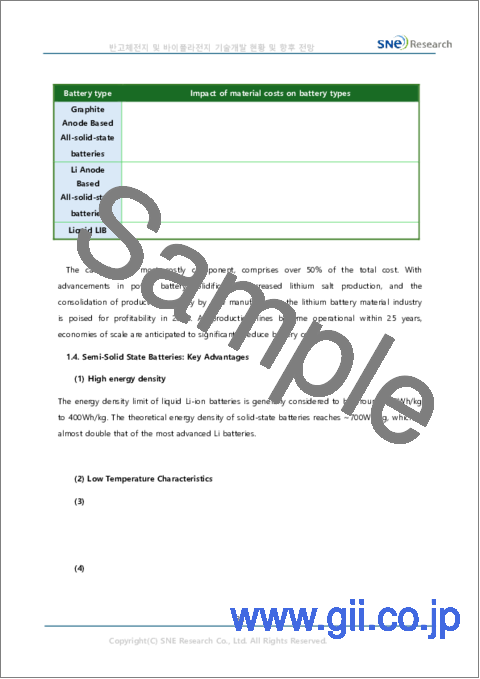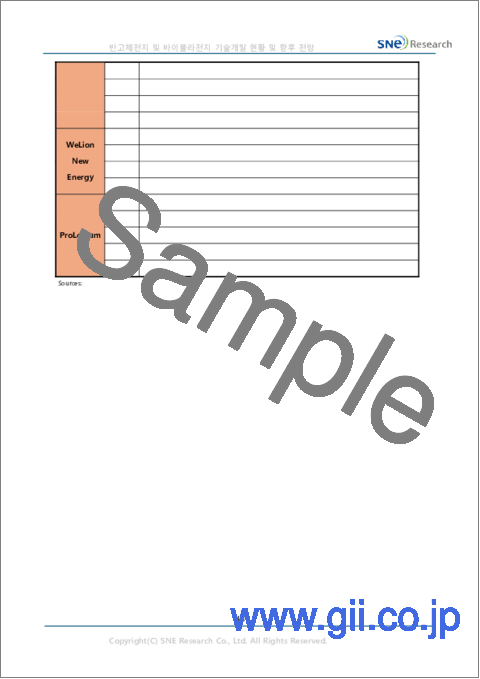|
|
市場調査レポート
商品コード
1473268
半固体電池技術:開発と将来展望<2024> Semi-Solid Battery Technology: Development and Future Prospects |
||||||
|
|||||||
| 半固体電池技術:開発と将来展望 |
|
出版日: 2024年04月08日
発行: SNE Research
ページ情報: 英文 241 Pages
納期: お問合せ
|
全表示
- 概要
- 目次
大手電池メーカーや自動車OEMは、全固体電池の大量生産を計画しています。しかし、これらの電池の大量生産には5~10年かかると予想されています。その一方で、従来のリチウムイオン電池 (LiB) よりも安全性、寿命、コスト面で優れている可能性があるとして、半固体電池への関心が高まっています。こうした期待から、特に中国の多くの企業が半固体電池の量産計画を発表しています。
半固体電池は、液体電池と固体電池の中間的な製品です。半固体電池は、界面を強化するために電池内に電解質の一部を組み込んでいます。液体電池と比較して、半固体電池は材料システムの変更を最小限に抑え、セパレーターと液体電解質を利用し、液体電解質の体積を減らすことができます。この削減により、電池のエネルギー密度と安全性を高めることができます。さらに、半固体電池の製造工程は、従来のリチウムイオン電池の技術や設備と密接に連携しています。
半固体電池では、液体を添加することで、電子輸送を損なうことなく複合材料を介したイオン輸送を促進し、電極の電気化学的性能を向上させることができます。そのためには、固体/液体の界面を通る低抵抗のイオン輸送が必要です。最近のin-situ重合技術は、半固体電池の元の液体成分を固化させることによって液体含有量を減らすために採用されています。
有機/無機複合固体電解質は、半固体電池において最も普及している形態の一つであり、有機固体電解質と無機固体電解質の両方の利点を兼ね備えています。これらの複合材料は、典型的には酸化物固体電解質とポリマー電解質からなり、卓越した引張強度と機械的特性、優れた加工性、十分なイオン伝導性を示し、大規模生産に適しています。
半固体電池の開発は、主にCATL、WeLion、Qingtao Energy、Ganfeng Lithium、Guoxuan、Farasis、Tailanなどの中国企業が牽引しています。さらに、LGES、Factorial Energy、SES、ProLogiumも独自に、あるいは自動車OEMと共同でこの技術を開発しています。
2023年の上海モーターショーで、CATLは待望のコンデンス・バッテリーを発表し、業界の注目を集めました。この画期的な技術は、高出力のバイオニック凝縮電解質を利用し、適応性のあるマイクロレベルネットワーク構造を特徴としています。これらの技術革新により、動的性能とリチウムイオンの輸送効率が向上し、従来のリチウムイオン電池を上回る500Wh/kgという驚異的なセルエネルギー密度を実現しました。さらに、CATLの技術革新は安定性と生産能力にも及んでおり、将来の電気自動車向けに信頼性と拡張性の高いソリューションを約束するものです。
固体電池の応用はすでに始まっており、150kWhを誇るWeLionの360Wh/kg半固体電池を搭載したNIO ET7は、従来の電池を上回る1145kmの航続距離を達成しました。量産開始は2024年4月とされています。
SNE Researchによると、世界の固体電池の生産能力は2030年には約168GWh、2035年には300GWhに達すると予想されています。電池市場全体のシェアでは、2030年の約5.7%から2033年には約6.55%でピークを迎え、その後、固体電池の普及に伴い2035年には再び5.7%まで低下すると予測されています。
当レポートでは、世界の半固体電池の技術・市場動向について分析し、半固体電池の概要・特性や分類、全固体電池との技術面での比較、電気自動車 (EV) などでの活用の見通し、今後の技術開発・市場成長の方向性、主要企業の中核特許、といった情報を取りまとめてお届けいたします。
当レポートのメリット:
- 1. 半固体電池を取り巻く最近動向を詳細にカバー
- 2. 主要な電池メーカーと自動車OEMを詳細にカバー
- 3. 競合情勢の把握:半固体電池と固体電池の比較
- 4. 半固体電池の開発の実績と現状
- 5. 半固体電池に関連する主要特許の分析
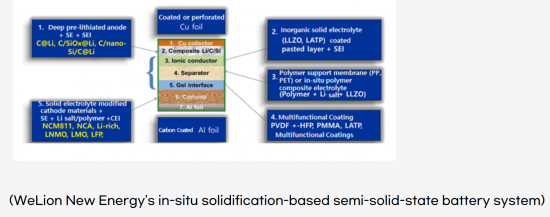
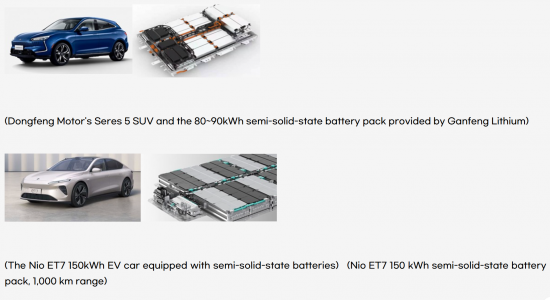
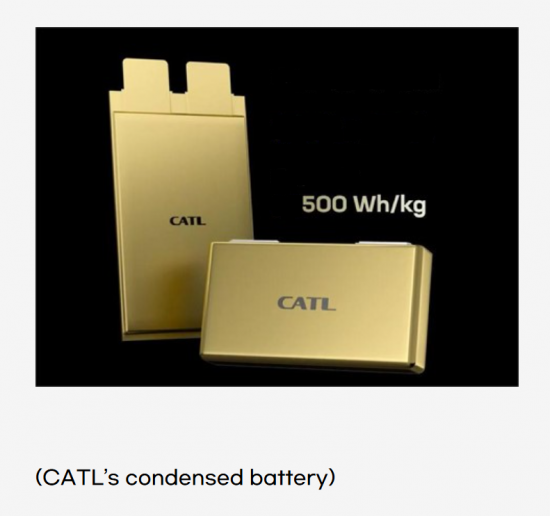
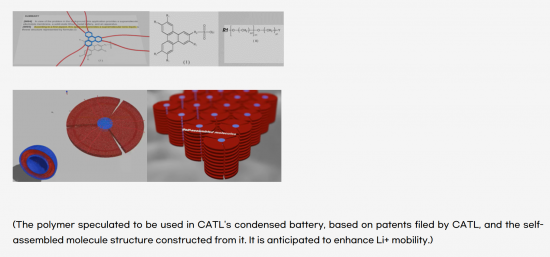
目次
第1章 半固体電池の開発動向
- 全固体電池の実用化の課題
- 全固体電池製造の未熟さ
- 半固体電池:産業チェーンへの影響
- 包装工程の改良:中間段階と後段階
- 固体電解質膜の形成プロセス
- 中核材料システムのイノベーション
- 半固体電池のコスト削減
- リチウム金属アノードの使用
- 規模の経済の必要性
- 半固体電池:主な利点
第2章 固体電池・半固体電池・ハイブリッド電池の分類
- 固体電解質の種類
- 電解質システムの分類
- 固体電解質の分類:長所と短所
- ハイブリッド電解質の種類
- ハイブリッド電解質の特性
- ハイブリッド無機ポリマー複合電解質 (IPC)
- 有機/無機ハイブリッド固体電解質
第3章 半固体電池用ポリマー/無機複合電解質
- 概要
- イントロダクション
- リチウムイオン伝導性
- 電気化学的安定性
- デンドライトの抑制
- 接触安定性
- ポリマー/無機複合電解質の充填剤
- ポリマー/無機複合電解質の成分
- 不活性充填剤
- 活性充填剤
- 高分子/無機複合電解質の合成
- 結論と要約
第4章 全固体電池と半固体電池の詳細分析
- 全固体/半固体電池の優位性 (エネルギー密度)
- 全固体/半固体電池の優位性 (安全性)
- 半固体電池の欠点
- 半固体電池のコストと将来展望
- 全固体電池/半固体電池の関連政策:国別
- 全固体/半固体電池の用途別市場
- 半固体電池の活用動向
- 酸化物固体電解質の生産能力 (企業別)
第5章 半固体電池:EVに最適なソリューションか?
- 半固体電池とその他の電池
- 半固体電池mp産業チェーン
- カソード/アノード材料
- 固体電解質
- EV市場
- 市場分析 (中国市場)
第6章 準固体リチウム電池の開発:中間層の応用
- 分析概要
- インタープレイヤーの役割
- Ag-C複合材料のLLZTOへの統合
- 追加レイヤーの導入
- 銀接着の強化
- リチウム金属セルの特性分析
- 電気化学セル
- LLZTOの電気化学的性能
- Li-Ag-C/Ag/LLZTO/IL-LCOセル
- 結論と考察
第7章 固体電池ハイブリッドインターフェース (SLEI)
- SLEI (固体・液体電解質インターフェース) の定義
- LIBと全固体電池の違い
- ハイブリッド固体電解質/液体電解質 (SE/LE) システム
- SLEIとSEIの類似点と相違点
- 酸化物系ハイブリッドシステム
- 硫化物系ハイブリッドシステム
- 純粋溶媒に関する調査
- 液体電解質の電気化学的性能
第8章 擬固体電解質を用いた高効率リチウム金属電池:MOF (金属有機構造体) の概要
- 分析概要
- 準固体電解質の製造
- ホスト材料としてのCuBTC MOF
- 準固体電解質の物理化学的性質
- 準固体電解質と電極の適合性
- NCM-811//Li パウチセルの電気化学的性能
- 結論
第9章 準固体電解質を用いたリチウム硫黄電池
- リチウム硫黄 (Li-S) 電池の概要
- 固体リチウム硫黄電池
- 動作原理
- 充電/放電プロファイル
- イオン伝導のメカニズム
- 技術的な問題
- 電解質材料の設計戦略
- 高分子電解質の用途
- ゲル/準固体ポリマー電解質
- 固体高分子電解質
- 無機固体電解質
- 硫化物固体電解質
- 酸化物固体電解質
- ハイブリッド電解質
- 無機有機複合電解質
- 無機固体液体電解質
- 結論と展望
第10章 半固体電池業界の動向
- 中国における半固体電池の現状
- 中国における全固体電池の研究開発 (R&D)
- 各社の投資状況
- 中国における全固体電池の展望
- 次世代電池の実用化
- 現在のLiBの改良における限界
- 半固体電池の継続的な開発
- 半固体電池の認知度の向上
- 固体電池の生産 (2026年以降)
- 日本企業:3~7年分の遅れ
- 世界の半固体電池の動向
- 正極・負極材料開発の動向
- バッテリー構造の脱モジュール化
- 半固体電池の量産開始
第11章 半固体電池メーカーと事業
- LGES
- SK On
- WeLion
- BAK
- CATL
- NIO
- KAERI(Korea)
- ProLogium
- SES
- Factorial Energy
- KIERKorea)
- imec
- Qingtao Energy
- Ganfeng Lithium
- Yiwei Lithium Energy (EVE)
- Guoxuan Hi-Tech
- Farasis Energy
- SVOLT
- SEMCORP
- NGK
- Kyocera
- Talent New Energy
第12章 半固体電池市場の展望
- 中国における半固体電池産業の現状
- 半固体電池産業の沿革
- 中国の半固体電池の関連政策
- 中国のEV向け半固体電池の需要見通し
- 中国における半固体電池の市場普及率
- 世界の半固体電池市場の見通し
第13章 半固体電池の特許分析
- Korea Institute of Energy Technology
- Qingtao New Energy
- LGES
- Arkema
- Global Graphene Group Inc.
- WeLion New Energy
- Ganfeng Lithium
- Sion Power
- Factorial Energy
- StoreDot
- SVOLT
参考文献
Major battery manufacturers and automotive OEMs are planning to mass-produce all-solid-state batteries. However, large-scale production of these batteries is expected to take 5-10 years. In the meantime, there's increasing interest in semi-solid-state batteries due to their potential safety, longevity, and cost advantages over conventional lithium-ion batteries (LiBs). This anticipation is driving many companies, especially in China, to announce mass production plans for semi-solid-state batteries.
Semi-solid-state batteries serve as a transitional product between liquid-state and solid-state batteries. They incorporate a portion of electrolyte within the battery to enhance the interface. Compared to liquid-state batteries, semi-solid-state batteries necessitate minimal alterations to the material system, utilize separators and liquid electrolytes, and can decrease the volume of liquid electrolyte present. This reduction can enhance battery energy density and safety. Moreover, the manufacturing processes for semi-solid-state batteries closely align with traditional lithium-ion battery techniques and equipment.
In semi-solid-state batteries, the addition of a liquid can enhance ion transport through the composite material without compromising electron transport, leading to improved electrochemical performance of the electrodes. This requires a low-resistance ion transport through the solid/liquid interface. Recent in-situ polymerization techniques have been employed to reduce the liquid content by solidifying the original liquid components of the semi-solid-state battery.
Organic-inorganic composite solid electrolytes, one of the most prevalent forms in semi-solid-state batteries, combine the advantages of both organic and inorganic solid electrolytes. These composite materials, typically consisting of oxide solid electrolytes and polymer electrolytes, exhibit exceptional tensile strength and mechanical properties, excellent processability, and adequate ion conductivity, making them suitable for large-scale production.
The development of semi-solid-state batteries is primarily being driven by Chinese companies, including CATL, WeLion, Qingtao Energy, Ganfeng Lithium, Guoxuan, Farasis, and Tailan. Additionally, LGES, Factorial Energy, SES, and ProLogium are also independently or collaboratively developing this technology with automotive OEMs.
At the 2023 Shanghai Auto Show, CATL unveiled its highly anticipated Condensed Battery, grabbing industry attention. This groundbreaking technology utilizes a high-power bionic condensed electrolyte and features an adaptive micro-level network structure. These innovations enhance dynamic performance and lithium ion transport efficiency, resulting in an impressive cell energy density of 500 Wh/kg, surpassing conventional lithium-ion batteries. Moreover, CATL's innovation extends to stability and production capabilities, promising a reliable and scalable solution for electric vehicles in the future.
The application of solid-state batteries has already begun, and the NIO ET7 equipped with WeLion's 360Wh/kg semi-solid-state battery, boasting 150kWh, achieved a range of 1145km, surpassing conventional batteries. It's reported that mass production started in April 2024.
According to SNE Research, global solid-state battery production capacity is expected to reach approximately 168GWh by 2030 and 300GWh by 2035. In terms of overall battery market share, it is projected to peak at around 6.55% in 2033 from approximately 5.7% in 2030, before declining to 5.7% again by 2035 as solid-state batteries are widely adopted.
The strong points of this report are as follows.
- 1. Detailed coverage of recent trends surrounding semi-solid-state batteries
- 2. Detailed coverage of major battery manufacturers and automotive OEMs
- 3. Navigating the Competitive Landscape: Semi-Solid-State Batteries vs. Solid-State Batteries
- 4. The development history and current status of semi-solid-state batteries
- 5. Analysis of key patents related to semi-solid-state batteries




Table of Contents
1. Semi-Solid-State Battery Development Trends
- 1.1. Commercialization Challenges for All-Solid-State Batteries
- 1.1.1. Immaturity of All-Solid-State Battery Manufacturing
- 1.2. Semi-Solid-State Batteries: Impact on the Industrial Chain
- 1.2.1. Modifications to the Packaging Process: Intermediate and Rear Stages
- 1.2.2. Solid Electrolyte Film Formation Process
- 1.2.3. Innovation in Core Material Systems
- 1.2.3.1. Polymer Systems
- 1.2.3.2. Oxide Systems
- 1.2.3.3. Sulfide Systems
- 1.2.3.4. Costs
- 1.2.3.5. Electrolyte
- 1.2.3.6. Anode Material
- 1.2.3.7. Binders
- 1.2.3.8. Pre-lithiation
- 1.2.3.9. Separators
- 1.2.3.10. Dry Electrode Process (DBE)
- 1.2.3.11. Industrialization Status of Semi-Solid Batteries
- 1.2.3.12. Gel-Type Solid Electrolyte
- 1.3. Reducing the Cost of Semi-Solid-State Batteries
- 1.3.1. Using Lithium Metal Anodes
- 1.3.2. Need for Economies of Scale
- 1.4. Semi-Solid State Batteries: Key Advantages
2. Classification of Solid-State, Semi-Solid-State, and Hybrid Batteries
- 2.1. Types of Solid Electrolytes
- 2.2. Classification of Electrolyte Systems
- 2.3. Classification of Solid Electrolytes and Their Pros and Cons
- 2.4. Types of Hybrid Electrolyte
- 2.5~7. Properties of Hybrid Electrolyte
- 2.8. Hybrid Inorganic Polymer Composite Electrolyte (IPC)
- 2.9~10. Organic-Inorganic Hybrid Solid-State Electrolyte
3. Polymer/Inorganic Composite Electrolytes for Semi-Solid-State Batteries
- 3.1. Overview
- 3.2. Introduction
- 3.2.1. Lithium Ion Conductivity
- 3.2.2. Electrochemical Stability
- 3.2.3. Dendrite Suppression
- 3.2.4. Contact Stability
- 3.3. Polymer/Inorganic Composite Electrolyte Fillers
- 3.3.1. Components of Polymer/Inorganic Composite Electrolytes
- 3.3.2. Inert Fillers
- 3.3.2.1. Oxide Fillers
- 3.3.2.2. Ferroelectric Fillers
- 3.3.2.3. Porous fillers
- 3.3.2.4. Other Inert Fillers
- 3.3.3. Active Fillers
- 3.3.3.1. Garnet-Type Solid Electrolytes
- 3.3.3.2. NASICON-Type Solid Electrolytes
- 3.3.3.3. Perovskite-Type Solid Electrolytes
- 3.3.3.4. Sulfide-Type Solid Electrolyte
- 3.3.4. Synthesis of Polymeric/Inorganic Complex Electrolytes
- 3.4. Conclusion and Summary
4. In-Depth Analysis of All/Semi-Solid-State Batteries
- 4.1. All/Semi-Solid-State Battery Advantage (Energy Density)
- 4.2. All/Semi-Solid-State Battery Advantage (Safety)
- 4.3. Semi-Solid-State Batteries Disadvantage
- 4.4. Semi-Solid-State Battery Costs and Future Outlook
- 4.5. All/Semi-Solid-State Battery Policies by Country
- 4.6. All/Semi-Solid-State Battery Application Market
- 4.7. Semi-Solid-State Battery Application Trends
- 4.8. Oxide Solid Electrolyte Production Capacity by Company
5. Semi-Solid-State Batteries: The Optimal Solution for EVs?
- 5.1. Semi-Solid-State Batteries vs. Other Batteries
- 5.2. Semi-Solid-State Battery Industry Chains
- 5.2.1. Cathode/Anode Materials
- 5.2.2. Solid Electrolytes
- 5.2.3. EV Market
- 5.2.4. Market Analysis (Chinese Market)
6. Quasi-Solid Lithium Battery Development: Interlayer Application
- 6.1. Research Overview
- 6.2. The Role of the Interplayer
- 6.3. Integrating Ag-C Composites into LLZTO
- 6.3.1. Introducing Additional Layers
- 6.3.2. Enhancement of Ag Adhesion
- 6.4. Analysis of Lithium Metal Cell Characteristics
- 6.4.1. Electrochemical Cell
- 6.4.2. .Electrochemical Performance of LLZTO
- 6.4.3. Li-Ag-C/Ag/LLZTO/IL-LCO Cell
- 6.5. Conclusion and Discussion
7. Solid-State Battery Hybrid Interface (SLEI)
- 7.1. Definition of SLEI(Solid-Liquid Electrolyte Interphase)
- 7.2. Difference between LIBs and All-Solid-State Batteries
- 7.3. Hybrid Solid Electrolyte/Liquid Electrolyte(SE/LE) Systems
- 7.4. Similarities and differences between SLEI and SEI
- 7.5. Oxide-Based Hybrid System
- 7.6. Sulfide-Based Hybrid System
- 7.6.1. Research on Pristine Solvents
- 7.6.2. Electrochemical Performance for Liquid Electrolytes
8. High-Efficiency Li Metal Batteries with Quasi-Solid Electrolytes (Introduction of MOFs)
- 8.1. Research Overview
- 8.2. Fabrication of Quasi-Solid Electrolytes
- 8.2.1. CuBTC MOF as a Host Material
- 8.2.2. Physicochemical Properties of Quasi-Solid Electrolytes
- 8.2.3. Compatibility of Quasi-Solid Electrolytes with Electrodes
- 8.2.4. Electrochemical Performance of NCM-811//Li Pouch Cells
- 8.3. Conclusion
9. Li-S Batteries with Quasi-Solid Electrolytes
- 9.1. Li-S Battery Overveiw
- 9.2. Solid-State Li-S Batteries
- 9.2.1. Operating Principle
- 9.2.2. . Charge/Discharge Profile
- 9.2.3. Ion Conduction Mechanisms
- 9.2.4. Technical Issues
- 9.3. Electrolyte Material Design Strategies
- 9.4. Polymer Electrolyte Applications
- 9.4.1. Gel/Quasi-Solid Polymer Electrolyte
- 9.4.2. Solid-Polymer Electrolyte
- 9.5. Inorganic Solid Electrolyte
- 9.5.1. Sulfide Solid Electrolyte
- 9.5.2. Oxide Solid Electrolyte
- 9.6. Hybrid Electrolyte
- 9.6.1. Inorganic-Organic Composite Electrolyte
- 9.6.2. Inorganic Solid-Liquid Electrolyte
- 9.7. Conclusion and Outlook
10. Semi-Solid-State Battery Industry Trends
- 10.1. The State of Semi-Solid-State Batteries in China
- 10.2. .All-Solid-State Battery R&D in China
- 10.3. Each Company's Investment Status
- 10.4. Outlook on All(Semi)-Solid-State Batteries in China
- 10.5. Commercialization of Next-Generation Batteries
- 10.5.1. Limitations in Improving Current LiBs
- 10.5.2. Continued Development of Semi-Solid-State Batteries
- 10.5.3. Growing Recognition of Semi-Solid-State Batteries
- 10.5.4. Solid-State Battery Production from 2026
- 10.5.5. Japanese Companies Lagging Behind by 3-7 Years
- 10.5.6. Global Trends in Semi-Solid-State-Batteries
- 10.5.7. Trends in Cathode/Anode Material Development
- 10.5.8. Demodularization of the Battery Structure
- 10.5.9. Mass Production of Semi-Solid-State Batteries Initiated
11. Semi-Solid-State Battery Manufacturers and Operations
- 11.1. LGES
- 11.2. SK On
- 11.3. WeLion
- 11.4. BAK
- 11.5. CATL
- 11.6. NIO
- 11.7. KAERI(Korea)
- 11.8. ProLogium
- 11.9. SES
- 11.10. Factorial Energy
- 11.11. KIERKorea)
- 11.12. imec
- 11.13. Qingtao Energy
- 11.14. Ganfeng Lithium
- 11.15. Yiwei Lithium Energy (EVE)
- 11.16. Guoxuan Hi-Tech
- 11.17. Farasis Energy
- 11.18. SVOLT
- 11.19. SEMCORP
- 11.20. NGK
- 11.21. Kyocera
- 11.22. Talent New Energy
12. Semi-Solid State Battery Market Outlook
- 12.1. Current Status of Semi-Solid-State Battery Industry in China
- 12.2. History of Semi-Solid-State Battery Industry
- 12.3. Policies for China's Semi-Solid-State Battery
- 12.4. China's Semi-Solid-State Battery Demand Outlook for EVs
- 12.5. Market Penetration Rate of Semi-Solid-State Batteries in China
- 12.6. Global Semi-Solid-State Battery Market Outlook
13. Patent Analysis of Semi-Solid-State Batteries
- 13.1. Korea Institute of Energy Technology
- 13.2. Qingtao New Energy
- 13.3. LGES
- 13.4. Arkema
- 13.5. Global Graphene Group Inc.
- 13.6. WeLion New Energy
- 13.7. Ganfeng Lithium
- 13.8. Sion Power
- 13.9. Factorial Energy
- 13.10. StoreDot
- 13.11. SVOLT
